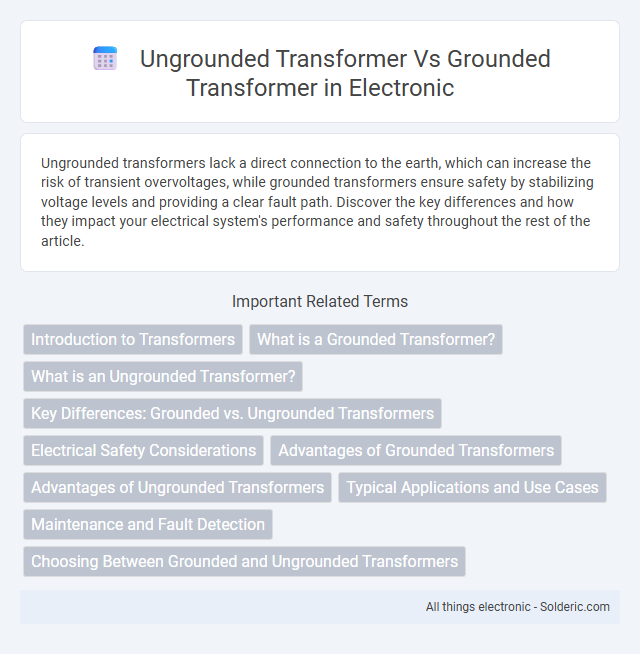Ungrounded transformers lack a direct connection to the earth, which can increase the risk of transient overvoltages, while grounded transformers ensure safety by stabilizing voltage levels and providing a clear fault path. Discover the key differences and how they impact your electrical system's performance and safety throughout the rest of the article.
Comparison Table
| Feature | Ungrounded Transformer | Grounded Transformer |
|---|---|---|
| Definition | Transformer model trained without external reference or context grounding. | Transformer model integrated with external knowledge or contextual grounding. |
| Contextual Awareness | Limited to learned patterns from training data. | Enhanced by real-world or domain-specific information. |
| Performance | Effective on general language tasks but can lack precision. | Improved accuracy and relevance in domain-specific or complex tasks. |
| Use Cases | General NLP applications like language modeling and generation. | Applications requiring factual accuracy, like QA systems and interactive agents. |
| Knowledge Integration | No direct access to external knowledge bases. | Incorporates external databases, structured knowledge, or sensors. |
| Adaptability | Relies solely on pretraining data. | Adaptable with real-time or updated contextual information. |
Introduction to Transformers
Transformers revolutionized natural language processing by introducing self-attention mechanisms enabling efficient parallelization and capturing long-range dependencies in text. Ungrounded transformers operate purely on input text without external context, focusing on internal linguistic patterns, while grounded transformers incorporate external data sources or world knowledge to enhance understanding and reasoning capabilities. This distinction impacts tasks like question answering, where grounded models demonstrate superior accuracy by leveraging factual information beyond the training corpus.
What is a Grounded Transformer?
A Grounded Transformer is a type of neural network model that integrates external knowledge or contextual information directly into its architecture, enabling more accurate and interpretable predictions. Unlike Ungrounded Transformers, which solely rely on training data patterns, Grounded Transformers leverage structured knowledge bases, real-world data, or explicit reasoning mechanisms to enhance understanding and reduce ambiguity. This grounding process improves performance in tasks like natural language understanding, question answering, and decision-making by aligning model outputs with factual context.
What is an Ungrounded Transformer?
An Ungrounded Transformer is a type of electrical transformer that does not have a direct connection to the earth or ground. It operates with primary and secondary windings isolated from the ground, often used in applications where grounding is either unnecessary or poses safety risks. This design minimizes the risk of ground faults and enables operation in environments with high fault tolerance requirements.
Key Differences: Grounded vs. Ungrounded Transformers
Grounded transformers have a physical connection between their neutral point and the earth, enhancing safety by stabilizing voltage during fault conditions and enabling effective fault current dissipation. Ungrounded transformers lack this earth connection, resulting in higher transient overvoltages but reduced earth fault current, which can minimize immediate damage yet complicates fault detection. Grounded transformers are commonly employed in distribution systems for improved protection and reliability, whereas ungrounded transformers are often used in specific industrial applications to maintain system continuity during single-line-to-ground faults.
Electrical Safety Considerations
Ungrounded transformers pose significant electrical safety risks due to the potential buildup of transient overvoltages and lack of a low-resistance path for fault currents, increasing the likelihood of insulation failure and electric shock hazards. Grounded transformers provide a controlled fault current path, ensuring quick operation of protective devices and minimizing the risk of electric shock and equipment damage. Compliance with electrical safety standards requires proper grounding to maintain system stability and protect personnel from hazardous voltage conditions.
Advantages of Grounded Transformers
Grounded transformers provide enhanced safety by effectively directing fault currents to the earth, reducing the risk of electrical shocks and equipment damage. Their design minimizes transient overvoltages, improving system stability and longevity, especially in sensitive industrial applications. Your electrical infrastructure benefits from improved fault detection and faster interruption, leading to increased reliability and protection against power surges.
Advantages of Ungrounded Transformers
Ungrounded transformers offer enhanced safety by minimizing the risk of electric shock and fire hazards due to the absence of a direct earth connection. They provide better continuity of supply during ground faults, reducing system downtime and improving reliability in critical applications. Their design also decreases transient overvoltages, which helps in protecting sensitive equipment and extending the operational lifespan of electrical components.
Typical Applications and Use Cases
Ungrounded transformers are commonly used in high-voltage power transmission systems and applications requiring electrical isolation without a direct connection to earth, such as industrial machinery and certain types of power distribution networks. Grounded transformers, on the other hand, are essential for safety and fault protection in residential, commercial, and utility power systems, ensuring stable voltage levels and reducing the risk of electric shock. Understanding which transformer suits your specific application helps optimize system reliability and safety.
Maintenance and Fault Detection
Ungrounded transformers require less frequent maintenance but are more susceptible to insulation faults due to the absence of a direct earth connection, making continuous fault detection critical to prevent damage. Grounded transformers offer improved safety and easier fault identification by providing a clear path for fault currents, enabling more accurate protection relays and faster troubleshooting. Implementing appropriate monitoring systems ensures your transformer's reliability by detecting insulation degradation or leakage currents, critical for minimizing downtime and maintenance costs.
Choosing Between Grounded and Ungrounded Transformers
Choosing between grounded and ungrounded transformers depends on your specific safety and fault detection requirements. Grounded transformers offer quicker fault current paths and easier fault location, enhancing protection and minimizing equipment damage. Ungrounded transformers provide continuity of service during single line faults but may require additional monitoring to detect high-resistance or arcing ground faults effectively.
ungrounded transformer vs grounded transformer Infographic

 solderic.com
solderic.com